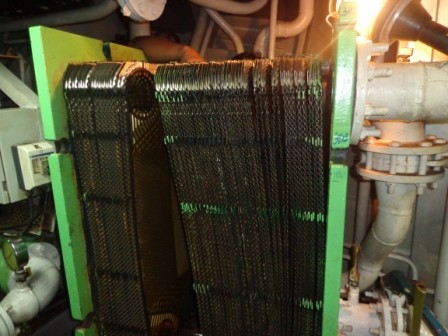Generally, the heat exchanger is define according to it construction and/or its purpose. They are as follows; a fluid heat exchanger, plate fin heat exchanger, plate and tube exchanger, plate heat exchanger, plate and shell exchanger, shell and tube heat exchanger, phase change, pillow plate, adiabatic wheel, etc.
Following these types of heat exchangers, there are mainly two types being used on board ship. They are ;
1. Plate type heat exchanger
This type of exchanger is designed with multiple parallel sets of plates which are being compressed to form the cooler unit, allowing fluid to pass between lines on the plate to the outlet holes. Furthermore, the exchanger gasket is placed on both side ends of the plate, which separates both substances from mixing up.
Use of Plate type heat exchanger
Plate exchanger is mostly used for lube oil and engine jacket water cooling. From my experience, the plate type seems to be the best exchanger in the terms of cooling effect and/or easy maintenance. In the terms of cleaning, it seems difficult and takes time.
2. Shell and tube heat exchanger
Shell and tube exchanger is designed with a bundle of tubes, which are placed inside the shell. This type of heat exchanger is being used on board the ship mainly on the steam condenser, jacket water cooling, as well as lube oil cool.
Also, see: proper lifting techniques at work
On board ships built 1994-2000 year back, many of them use the shell and tube exchanger. while that of 2000 years upwards are mainly installed the plate type.
Effective
Relating both exchangers, to my own opinion and statistics, the plate type exchanger is more effective and durability. But its durability and effectiveness depend on how it’s been managed.
The shell and tube exchanger has it advantages too, which includes; easy to clean tubes, difficult to mix up except if the tubes leaks. While plate type can mix up easily if the gaskets are not placed very well.
Conclusion
To bring to a conclusion, as a seafarer, you man encounter any of the above exchangers while on board ship. The best way to manage them and have good cooling effects is to maintain proper cleaning of the coolers, check and allow recommended temperature, check, change the gaskets as required. With all these, you can have the exchangers save you better. ALso you might want to learn more about Marine Diesel Basics : Maintenance, Lay-up, Winter Protection, Tropical Storage, Spring Recommission.
I hope this article helps and/or gives you more insight regarding this equipment. Share to reach your friends, who may need this article, also subscribe below for our weekly post.











